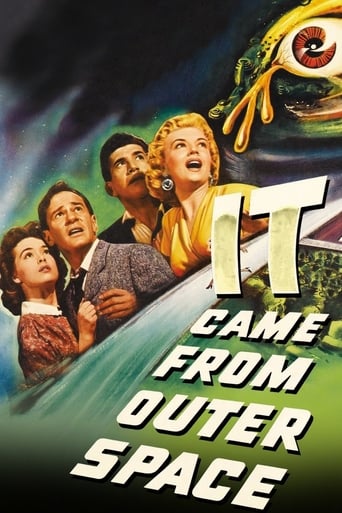

This was far better than the early anaglyph version.It had no ghosting.If i did not write to universal and suggested that they put it out for American audiences ,we never see it in Blu ray 3D.Some time back I found out that Panamint was going to release it with the 3d short ,which had premiered with the feature back in 53, The first Hollywood 3d revue with Nat king Cole and Russ Morgan and his orchestra.The only problem was that universe decided not to include the short ,which was crummy and selfish .The fact that panamint was going to include the short. .Universal did not show it in the widescreen format neither that it was premiered Well if it wasn't shot for wide screen and they just cropped it for premiere well your seeing the whole picture any way.That was the only problem.In spite of not seeing the music in the Morgan manner in 3d ,the feature alone was worth watching.The scene were the monster was portraying Ellen shooting rays at John,the clear Blu- ray 3d ,the rays were more dimensional than in the anaglyph version This also includes a documentary about universal Sci-Fi films .It had an older interview of Bob Furmanek.Fun and entertaining.10/4/16
... View MoreBeautiful long shots of barren desserts. And of cars going down empty American highways. Barbara Rush was easy on the eyes. Richard Carlson was sort of an all American leading man. He plays the only sane person in a small desert town which intensely fears the space ship that has landed in the desert.The bubble like creatures from the space ship were good enough for the time this film was made, I guess.Like other sci-fi movies of the time (eg. The Day the Earth Stood Still in 1951) the film portrays base human instincts as negative and violent. Even the background score is quite similar to The Day the Earth Stood Still. The movie is based on a story by Ray Bradbury.(6/10)
... View MoreA lot of people will wonder why I've rated this 9 out of 10 ? The answer is simple , Jack Arnolds direction is spot on , the script by Harry Essex , based on a Ray Bradbury story , "The Meteor" , is well above average for 50's sci-fi , the special effects are excellent , for the period , the acting , particularly , by the leads , is excellent , the music is genuinely spooky , the camera-work showing things from the aliens point of view is very effective and it has some original ideas . For example , it was the first movie to have aliens replicating humans and , in an era where the alien was invariably a man in a rubber suit , there was a genuine attempt at making the alien original and scary . All on a budget of less than a million dollars , which for its day was a decent amount and was definitely not a b picture budget ! Comparing it with todays mega bucks films with their CGI special effects is not being in the least bit fair . I note that a lot of reviewers are of the opinion that Space Children was Jack Arnolds favorite movie and his best . I have seen all of Jack Arnolds films and consider Space Children his worst . Even Monster On The Campus was better ! I have looked everywhere and can find no reference to Jack Arnold referring to it as his favorite movie . I suspect it falls into the urban legend category . In my opinion Jack Arnolds best sci-fi movie was The Incredible Shrinking Man , thanks to a superb script by Richard Matheson and what was the most incredible thing about that movie was that the studio heads allowed that ending .
... View MoreFirst Contact from the Star Trek series explores a lot of the same issues that It Came From Outer Space Does. Of course First Contact was made presumably in this century when the optimistic Gene Roddenberry felt that man would grow up and mature a bit. As opposed to those humans in this small Arizona town who except for Richard Carlson who is an astronomer and writer believe in the old west tradition of shoot first.It Came From Outer Space is set in the paranoid Fifties and Richard Carlson who is courting Barbara Rush along with sheriff Charles Drake is on an outing with Rush when what he believes is a ship crashes to the earth and leaves a nice deep crater hole as it burrows into the ground.Carlson has his problems first authorities don't believe him, second when people start disappearing, everyone goes into panic mode. What's a thinking scientist to do. Remember it's not the scientists who were working on making First Contact that the aliens will be dealing with.These issues are explored and most carefully by author Ray Bradbury who wrote the original story on which It Came From Outer Space is based. The special effects are outmoded and the issue at times is dealt with simplistically, but the message is as strong now as it was six decades ago. I suppose it comes down to will enough of us on both sides of the First Contact be mature enough to handle it and respond appropriately.
... View More